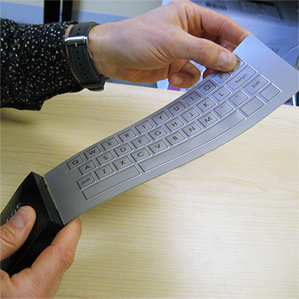A Flexible Keyboard with Buttons That Feel Clickable
A very thin keyboard that uses shape-changing polymers to replicate the feel and sound of chunky, clicking buttons could be in laptops and ultrabooks next year. Strategic Polymers Sciences, the San Francisco-based company that developed the keyboard, is working on transparent coatings that would enable this feature in touch screens.

Today’s portable electronics provide rudimentary tactile feedback—many cell phones can vibrate to confirm that the user has pressed a button on a touch screen, for example. These vibrations are produced by a small motor, meaning the entire phone will move rather than just the appropriate spot on the screen where the button is, and there can be a lag in response time.
“It’s amazing how fast software has grown to compensate for problems with touch screens—and sometimes you still text a word that’s the opposite of what you mean,” says Christophe Ramstein, CEO of Strategic Polymers. Haptics researchers hope to improve user interfaces by making the sensations of interacting with virtual buttons more like touching physical objects.
Strategic Polymers’ technology is a polymer that dramatically and rapidly changes its shape under an applied electric field. The letters on the company’s haptic keyboard vibrate to confirm that they’ve been pressed; that vibration can also be used to create sound waves, so the keys can click, or even play music. The advantage of the haptic keyboard over one with physical buttons, says Ramstein, is that it’s just 1.5 millimeters thick, and it’s flexible. Ramstein says the company, which has manufacturing facilities in State College, Pennsylvania, plans to ship the keyboards to equipment manufacturers in 2014.
There are other materials that provide this kind of response to electric fields, but they don’t have the ideal balance of properties, says Qiming Zhang, cofounder of the company and a professor of electrical engineering at Penn State University. On the one side, there are very hard ceramic materials called piezoelectrics that can respond rapidly to voltage, but don’t provide much shape change. On the other are other electrically responsive polymers that can dramatically change shape but work slowly. The new polymers respond in milliseconds, change their shape by as much as 10 percent, and respond to small voltages, says Zhang.
“There’s a sweet spot where you can generate vibrations particularly attuned to the human sense of touch,” says J. Edward Colgate, professor of mechanical engineering at Northwestern University in Evanston, Illinois, who is not affiliated with the company.
“These materials are hard to break and you can form them into different shapes,” he says. Since the polymers are transparent and flexible, they could be molded onto steering wheels, wearable electronics, touch screens, and other places, he notes.
Indeed, Ramstein says the company’s future products will take advantage of the polymers’ transparency and flexibility. One prototype is a cell phone with pads on the back that vibrate to indicate right and left turns or notable sights during navigation. The company is also working on a fully transparent keyboard with buttons that would physically pop up from the surface of a touch screen when activated, and then return to a smooth state.
Keep Reading
Most Popular
Large language models can do jaw-dropping things. But nobody knows exactly why.
And that's a problem. Figuring it out is one of the biggest scientific puzzles of our time and a crucial step towards controlling more powerful future models.
The problem with plug-in hybrids? Their drivers.
Plug-in hybrids are often sold as a transition to EVs, but new data from Europe shows we’re still underestimating the emissions they produce.
Google DeepMind’s new generative model makes Super Mario–like games from scratch
Genie learns how to control games by watching hours and hours of video. It could help train next-gen robots too.
How scientists traced a mysterious covid case back to six toilets
When wastewater surveillance turns into a hunt for a single infected individual, the ethics get tricky.
Stay connected
Get the latest updates from
MIT Technology Review
Discover special offers, top stories, upcoming events, and more.